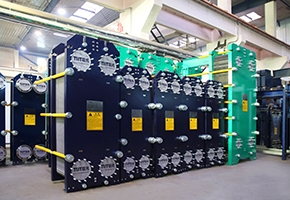welded plate heat exchanger
 THT Megaelement
THT Megaelement

In the domestic metallurgy, alcohol and other industries, the operating medium of some process sections contains a large number of solid particles, fiber suspensions and viscous materials. In order to effectively prevent the deposition of solid particles or suspensions in the medium, blocking channels, wearing heat transfer elements and other phenomena, the heat exchange requirements of large processing capacity, high heat transfer efficiency, high pressure, temperature and wear resistance, and low Friction loss are realized.
THT Juyuan has successfully developed a fully welded wide channel plate heat exchanger based on its strong technical strength and years of experience in the development of plate heat exchangers. The fully welded wide channel plate heat exchanger has been successfully applied in alcohol, alumina and other industries. It is suitable for the operation of process media such as fermentation mash, saccharification mash, Aluminium hydroxide slurry, etc. It has the characteristics of high heat transfer efficiency, long service life, and easy maintenance, and has replaced the spiral plate heat exchanger in the relevant process.
Product composition
The fully welded wide channel plate heat exchanger is a type of plate heat exchanger manufactured by welding plates. The heat exchanger consists of main components such as plate bundles, guide tube boxes, buffer tube boxes, compression plates, clamping bolts, flange cover plates, and supports. Plate bundles are the core of heat transfer, in which the plates serve as thermal conductive components that determine the thermal performance of the heat exchanger. The pressure capacity of the heat exchanger and the safety and reliability of its operation are mainly determined by the pipe box, clamping plate, and clamping bolt.
operational principle
The fully welded wide channel plate heat exchanger belongs to the inter wall type heat exchanger, and the structural form of the heat exchanger adopts a combination mode of wide and narrow channels. The wide channel passes through the material, while the narrow channel passes through the cooling medium. At the same time, different channel spacing can be designed and manufactured according to different operating medium parameters. Usually, the fluid channel formed by the wide channel side is called the plate pass, while the fluid channel formed by the narrow channel side is called the tube pass. When the plate side and tube side pass through two different temperatures of fluids, the higher temperature fluid transfers heat to the lower temperature fluid through the heat exchange plate. The higher temperature fluid is cooled and the lower temperature fluid is heated, thereby achieving the purpose of the two fluid heat transfer processes.

 中文
中文 English
English Россия
Россия








